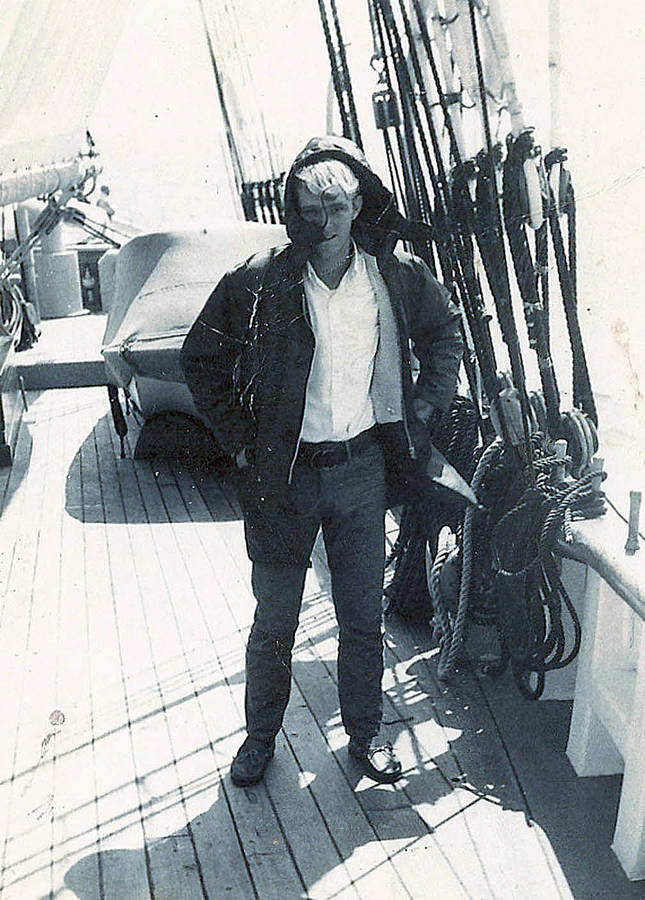
2021-02-03
Rhapsody on Bluenose
Lou Boudreau is a lifelong sailor and pioneer in the luxury sailing cruise industry. A back injury had him set sail in a new life direction and toward a future as a writer. His published works include The Man Who Loved Schooners (Tiller Publishing), Fandango's Gold (Tiller Publishing) and Where the Trade Winds Blow (Bryler Publications.)
As The Bluenose celebrates her 100th anniversary this year, Boudreau shares with readers of LighthouseNOW this two-part tale of his time as a teen working aboard Canada's iconic schooner. It's an abridged version of his story, A Year Before The Mast - A Voyage in the Schooner Bluenose II, which appears in his upcoming book, The Voyage and Other Tales of the Sea. For more on Boudreau, visit his website: https://wherethetradewindsblow.ca/
PART ONE:
By LOU BOUDREAU
Gazing out over the ocean, I take a deep breath. A low fog bank hovers just beyond the Mahone Bay islands, a tangible if not impenetrable barrier between the land and the blue sea beyond. There is magic here, and sometimes, on days like this and as I look out over the bay, I imagine the ghost of a tall Atlantic schooner racing across the ocean. I see her topmasts bending under a press of sail and hear the whistle of the wind in her rigging. Her huge white bow wave rolls gracefully away to leeward, and I can almost hear the creak of block and tackle.
But it's no dream or fancy of my imagination; it's a memory. There was a time years ago when it truly had been just a dream. I was but a youth when I went to sea in her, a young man following his heart to sail across the oceans in search of adventure. It had been a time of great awakenings, when, like an open ledger, the pages of my mind were waiting to be filled.
Taking an old leather-bound journal from the side table, I run my hand over the cover. Almost 50 years have passed, but the legendary schooner's name - "Bluenose II" - that I inscribed upon it with the tip of my seaman's knife is still clear. Smiling slightly I close my eyes, and the result is inevitable.
As if caught in a time warp, the years roll back and I'm standing on her deck again, struggling to hold the big schooner to her northerly course as my hands begin to cramp. The pressure of the big wheel's thick spokes have moulded my palms into two almost paralytic claws and. even though I've only been on the helm for 40 minutes of my scheduled two-hour wheel watch, it seems like an eternity.
We're on the starboard tack under storm trysail foresail and headsails beneath an ever darkening sky. As another of the strengthening gusts hit us, the big wooden schooner's 43.6-metre (143-foot) hull heels over until her varnished cap rail disappears under the white water rushing down her lee side. The big brass compass port that we polished so religiously over the previous months is now green streaked and coated with north Atlantic salt.
Looking inside, I catch the lubber line moving almost imperceptibly to the west. Handing a couple of spokes to port, I haul her down again. The skipper is standing, as he always does, just to windward and forward of the helm position, legs spread with feet planted firmly on the deck to brace against the roll. He purses his lips slightly; am I handling her right?
I had joined the Bluenose II in 1969, at the age of 18 and in Marigot Bay, St. Lucia, where my father ran his schooner cruise business. We sailed the next day.
After boarding our new passengers mid-morning, we heaved anchor bound for a group of islands to the south known as the Tobago Cays. Under the able command of Captain Ellsworth T. Coggins, the big schooner filled her white wings and reaped the north east trade wind, just off the quarter.
The Bluenose was awakening. She had been asleep before, but now her spirit stirs. The creaking of the blocks and the sounds of the sails are signals that soon she will be doing that for which she was built. She shudders slightly, anticipating the moment when her wings will fill with the freshening breeze.
We handle the downhaul, guy and topsail sheet the same way we did on the main. The mate, Skodje, sheets it out the same extent as the main, and the skipper lets the Bluenose come a little more to starboard now, filling the main and foresail. Of all the sounds on our schooner - the creaking of the blocks, the gurgling sound of the sea as it runs aft along the lee rail, the sounds of the big galvanised hanks whizzing up the head stays - are most like music to my ears. There's a good pair on the halyard, working well together, hands over hand and chanting as they go. 'One, two, One two, One two."
The Bluenose is under what we call the four lowers - main, foresail, jib and jumbo. The skipper brings her onto her course on the port tack and we go about trimming up for the slant. Our course puts the wind abeam and the sails need to be sheeted in or out to suit. Meanwhile, we're beginning to trim the sheets from aft. The big schooner is feeling the freshening breeze, and I'm excited.
The mate goes to the big main sheet bit and slacks a few feet. There is a slight groove that the heavy line is even now making for itself in the new wood. The big sail and boom edge slowly out over the water. When he judges it to be right, he makes fast and moves to the foresails. Each sail is trimmed to the one aft of it as well as for the wind. The foresail is back winding the main now and we slack it out until it stops. As soon as the dimple in the leading edge of the mainsail disappears, we know that we've got it pretty close.
The foresail boom is then set so that it is lying at an angle just slightly less than that of the main. Then on to the jumbo, and finally the jib. When Skodje's trimmed the four lowers to his satisfaction, he comes aft again.
"How's that look Skipper?" he asks.
Captain Coggins looks forward for a moment, and then nods. From our location at the stern of the schooner we can sight along the deck and I see that the three booms - main, fore, and jumbo - all line up together, with the angle decreasing only a few degrees or so going forward. The jib's outer curve follows the shape of the others exactly. The sails are well trimmed for this course and the Bluenose comes alive.
To be continued ..






